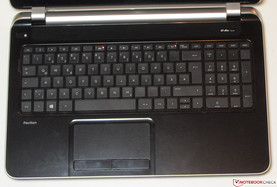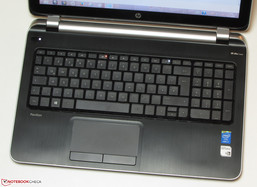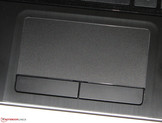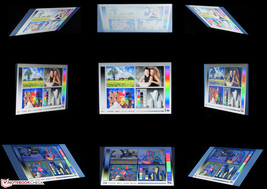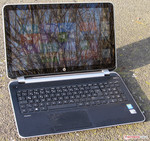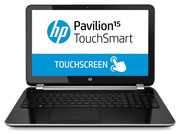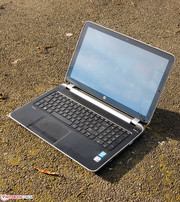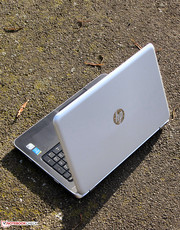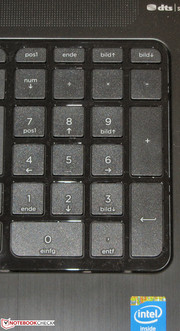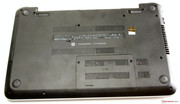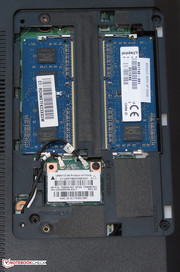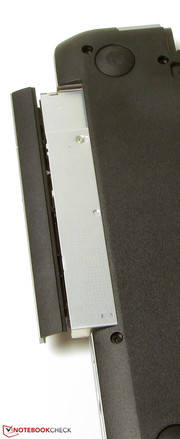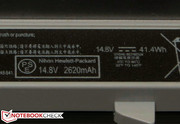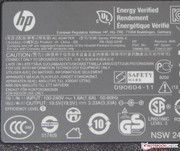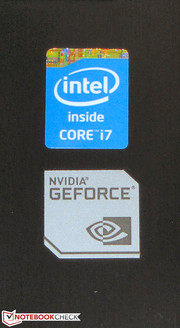Review HP Pavilion TouchSmart 15-n010sg Notebook

For the original German review, see here.
The choice for users looking for a slim and handy 15.6-inch all-round laptop has now been expanded by the Pavilion TouchSmart 15-n010sg. With a height of 23 mm (~0.91 inches) and a weight of 2.3 kg (~5.1 pounds), the laptop is within ultrabook standards. However, it is not an ultrabook. Hewlett Packard offers its TouchSmart laptops in different sizes. We recently tested the 11.6-inch Pavilion TouchSmart 11-e000sb (AMD A4-1250, Radeon HD 8210). As for looks, the TouchSmart 15 fits in Hewlett Packard's current Pavilion 15 series and has a lot in common with these models. We previously put a series model through its paces in the form of the Pavilion 15-n005sg (Core i5-4200U, HD Graphics 4400). The TouchSmart made a recommendable impression on paper at the time. Our test report uncovers whether this is really true.
We used the Acer Aspire TimelineU M3-581PTG (Core i5-3337U, GeForce GT 730M) and Asus N56VB-S4050H (Core i7-3630QM, GeForce GT 740M) for classifying the laptop. The latter does not feature a touchscreen.
Since the Pavilion TouchSmart 15-n010sg and the Pavilion 15-n005sg are largely identical, we would refer to the review of the Pavilion 15 for details about casing, connectivity, keyboard and speakers.
Case
The TouchSmart has its shape, size, and weight in common with the Pavilion 15-n005sg. We did not notice any differences regarding stability either. However, this changes in the choice of colors and materials. The upper side of the TouchSmart's base unit is made of black, brushed aluminum. Hewlett Packard omits the additional dark dots on the lid's silver-gray back, that were used on the Pavilion 15-n005sg.
Input Devices
Keyboard and Touchpad
The TouchSmart's keyboard is identical to that of the Pavilion 15-n005sg. However, a different touchpad unit is used. Unlike the Pavilion's touchpad, it is not part of the wrist rest. The approximately 11 x 5.2 cm (~4.3 x 2.0 in.) multi-touch capable pad in the TouchSmart features a very lightly roughened surface. The fingers easily glide over the pad. Single gestures can be turned on and off in the pad's settings menu. Not all available gestures are enabled by default. Both mouse keys exhibit a clearly audible and palpable pressure point, as well as a short drop.
Touchscreen
Another input option of the TouchSmart is a touchscreen. Hewlett Packard installs a capacitive model in its laptop. The screen did not cause any problems and responded immediately to inputs.
Display
The reflective-type 15.6-inch screen in the TouchSmart works with a native resolution of 1366x768 pixels. Its average brightness of 142.6 cd/m² is anything but good. An 800 Euro (~$1088) laptop should simply not feature such a low rate. The screen in the Aspire (203.1 cd/m²) does a better job, but neither laptop achieves the very good rate of the N56VB (360.4 cd/m²). The Asus laptop is also the only one that features a matte, Full HD screen.
| |||||||||||||||||||||||||
Brightness Distribution: 68 %
Center on Battery: 145 cd/m²
Contrast: 681:1 (Black: 0.21 cd/m²)
ΔE ColorChecker Calman: 9.32 | ∀{0.5-29.43 Ø4.78}
ΔE Greyscale Calman: 9.01 | ∀{0.09-98 Ø5}
35.74% AdobeRGB 1998 (Argyll 1.6.3 3D)
39.05% AdobeRGB 1998 (Argyll 3D)
55.4% sRGB (Argyll 3D)
37.55% Display P3 (Argyll 3D)
Gamma: 2.35
CCT: 11185 K
Unlike the brightness, the screen's contrast of 681:1 and black value of 0.21 cd/m² are good. The Aspire (495:1; 0.42 cd/m²) fall behind the TouchSmart in this regard. The screen in the N56VB (765:1; 0.52 cd/m²) has a slightly better contrast ratio. A look at the color space screenshots shows that the screen cannot reproduce either the sRGB (50.2 percent) or the AdobeRGB (35.7 percent) color space. These color spaces are important, for example, in professional image editing.
We assessed the screen in its delivery state (target color space sRGB). The average DeltaE 2000 deviation is approximately 9. No color achieves the target range (DeltaE smaller than 3). The screen has a bluish cast.
Outdoor use should not even be remotely considered. The screen's brightness is not high enough for this purpose, and its surface is also highly reflective, making this intention even more difficult.
The TouchSmart's viewing angles are not compelling either. They are within the range of many ultra-budget laptops. Changing the vertical viewing angle quickly leads to image distortions. The angle is more generous horizontally. We would have at least expected a higher-quality TN screen with somewhat larger viewing angles in an 800 Euro (~$1088) laptop.
Performance
The TouchSmart is an all-round laptop in a 15.6-inch size. In addition to routine tasks, the laptop also copes with current 3D computer games. The laptop is part of Hewlett Packard's latest Pavilion 15 series. It consists of many different laptops that are based on either Intel or AMD technology. We previously tested two members of this line with the Pavilion 15-n005sg (Core i5-4200U, HD Graphics 4400) and Pavilion 15-e052sg (AMD A8-5550M, AMD Radeon HD 8550G + HD 8670M Dual Graphics.
Processor
Hewlett Packard equips the TouchSmart with a Core i7-4500U processor. This dual-core processor is based on Intel's latest Haswell architecture. It works with a base speed of 1.8 GHz, and can increase this speed to 2.7 GHz (both cores) or 3 GHz (one core) via Turbo. The processor supports Hyperthreading. A prominent feature of the CPU is its relatively low power consumption due to a low voltage (ULV processor). Intel specifies a TDP of 15 Watts for the Core i7.
The Core i7 processed the single thread tests of the Cinebench benchmarks with 2.7 GHz. One core was recurrently boosted to 3 GHz. The CPU started the multi-thread tests with 2.7 GHz. Its speed dropped to 2.6 GHz after about half the time. The TouchSmart consistently supplies better scores than the Aspire (Core i5-3337U, GeForce GT 730M), which is no surprise because the Core i7 in HP's laptop works with higher Turbo speeds and benefits from the improvements in the Haswell architecture. The TouchSmart can match the N56VB (Core i7-3630QM, GeForce GT 740M) in single thread applications. The Asus laptop takes the lead in multi-thread applications because it sports a quad-core processor that clocks with much higher speeds. However, we should keep in mind that it is a standard mobile processor with a TDP of 45 Watts. The N56VB and TouchSmart are equivalent in the GL tests.
System Performance
The system will not break any records, but it runs smoothly. The good PCMark benchmarks confirm this. The N56VB (Core i7-3630QM, GeForce GT 740M) is on par with the TouchSmart. The Aspire (Core i5-3337U, GeForce GT 730M) scores much better than its contenders due to its solid state drive.
| PCMark Vantage Result | 7216 points | |
| PCMark 7 Score | 3034 points | |
| PCMark 8 Home Score Accelerated | 3070 points | |
| PCMark 8 Work Score Accelerated | 4562 points | |
Help | ||
Storage Devices
Our review samples sports a hard drive from Seagate. It has a capacity of 500 GB and spins at 5400 revolutions per minute. We would have expected an additional SSD cache or optional hybrid hard drive for a laptop price of approximately 800 Euros (~$1088). CrystalDiskMark recorded a read speed of 102.3 MB/s. HD Tune delivered an average transfer rate of 80.9 MB/s. The rates are acceptable for a 5400-rpm drive. However, the transfer rates of small data blocks (4kb) are not overwhelming. Other hard drives have more to offer in this regard.
Graphics Card
Two graphics chips are installed in the TouchSmart: Intel's HD Graphics 4400 GPU and Nvidia's GeForce GT 740M graphics core. They are responsible for different tasks. While the Intel core is active in routine and battery mode, the GeForce GPU takes care of performance devouring applications, such as computer games. Both chips support DirectX 11.1. The GeForce is a midrange chip that has a base speed of 980 MHz. Its speed can be increased to 1058 MHz via Turbo.
Although both devices sport the same GPU, the TouchSmart's scores in the 3DMark benchmarks are lower than those of the N56VB (Core i7-3630QM, GeForce GT 740M). The reason for this is that the laptops use different versions of the GeForce graphics chip. The graphics memory in the Asus laptop is connected to the GPU via a 128-bit line, whereas it is only a 64-bit interface for the TouchSmart's memory. Thus, the GPU in HP's laptop is slowed down. The TouchSmart also scores lower than the Aspire (Core i5-3337U, GeForce GT 730), which sports a marginally weaker GPU. Since the graphics memory in the Aspire has a 128-bit bus, the GPU does more than just compensate its lower clock rate compared with the GeForce GT 740M GPU.
| 3DMark 06 Standard Score | 9301 points | |
| 3DMark Vantage P Result | 6141 points | |
| 3DMark 11 Performance | 1940 points | |
| 3DMark Ice Storm Standard Score | 55133 points | |
| 3DMark Cloud Gate Standard Score | 5466 points | |
| 3DMark Fire Strike Score | 1065 points | |
Help | ||
| HP Pavilion TouchSmart 15-n010sg GeForce GT 740M, 4500U, Seagate Momentus Thin ST500LT0 12-9WS142 | Asus N56VB-S4050H GeForce GT 740M, 3630QM, WDC Scorpio Blue WD7500BPVT-80HXZT3 | Acer Aspire TimelineU M3-581PTG-53334G25Makk GeForce GT 730M, 3337U, TOSHIBA THNSNS256GMCP | Acer Aspire V5-573G-54208G50aii GeForce GT 750M, 4200U, Seagate Momentus Thin ST500LT0 12-9WS142 | |
|---|---|---|---|---|
| 3DMark | 31% | 8% | 4% | |
| 1280x720 Ice Storm Standard Score (Points) | 55133 | 67664 23% | 58274 6% | 39694 -28% |
| 1280x720 Cloud Gate Standard Score (Points) | 5466 | 8226 50% | 5938 9% | 5855 7% |
| 1920x1080 Fire Strike Score (Points) | 1065 | 1269 19% | 1168 10% | 1420 33% |
Gaming Performance
The laptop can run most games in its native resolution of 1366x768 pixels using medium quality settings. However, it becomes apparent that the graphics memory is connected with only a 64-bit interface even in games. Like in the 3D benchmarks, the Aspire and Asus laptops deliver better results in the form of higher frame rates.
Users who like to play regularly will be happier with the contenders. An alternative to all three laptops would be Acer's Aspire V5-573G (Core i5-4200U, GeForce GT 750M). The version we tested costs approximately 700 Euros (~$952), but it is on the TouchSmart's price level of 800 Euros (~$1088) when it is configured with a Core i7 instead of a Core i5 processor. The V5-573G comes with a matte screen in either case.
| low | med. | high | ultra | |
|---|---|---|---|---|
| Anno 2070 (2011) | 109.5 | 49.8 | 29.9 | |
| Dishonored (2012) | 72.1 | 55.1 | 47.4 | |
| Tomb Raider (2013) | 87.5 | 42.7 | 23.9 | |
| Need for Speed: Rivals (2013) | 29.9 | 23.5 | ||
| Assassin´s Creed IV: Black Flag (2013) | 37.9 | 28.8 | 13.9 |
| HP Pavilion TouchSmart 15-n010sg GeForce GT 740M, 4500U, Seagate Momentus Thin ST500LT0 12-9WS142 | Asus N56VB-S4050H GeForce GT 740M, 3630QM, WDC Scorpio Blue WD7500BPVT-80HXZT3 | Acer Aspire TimelineU M3-581PTG-53334G25Makk GeForce GT 730M, 3337U, TOSHIBA THNSNS256GMCP | Acer Aspire V5-573G-54208G50aii GeForce GT 750M, 4200U, Seagate Momentus Thin ST500LT0 12-9WS142 | |
|---|---|---|---|---|
| Dishonored | 42% | 28% | ||
| 1024x768 Low / Off, FOV: 75 (fps) | 72.1 | 97.7 36% | 75.8 5% | |
| 1366x768 Medium / Off, FOV: 75 (fps) | 55.1 | 78.9 43% | 73.9 34% | |
| 1366x768 High / On, FOV: 75 AA:FX (fps) | 47.4 | 70.2 48% | 68.5 45% | |
| Anno 2070 | 26% | |||
| 1024x768 Low Preset (fps) | 109.5 | 133.2 22% | ||
| 1366x768 Medium Preset AA:on (fps) | 49.8 | 63.7 28% | ||
| 1366x768 High Preset AA:on AF:2x (fps) | 29.9 | 37.9 27% | ||
| Tomb Raider | 37% | 53% | ||
| 1024x768 Low Preset (fps) | 87.5 | 111.4 27% | 120.4 38% | |
| 1366x768 Normal Preset AA:FX AF:4x (fps) | 42.7 | 57.9 36% | 65.4 53% | |
| 1366x768 High Preset AA:FX AF:8x (fps) | 23.9 | 35.3 48% | 39.8 67% | |
| Total Average (Program / Settings) | 40% /
40% | 27% /
27% | 53% /
53% |
Emissions
System Noise
We measured an acceptable noise level of 31.7 to 32.7 dB(A) in idle mode. The N56VB (29.8 to 32.8 dB(A)) achieves somewhat better rates; the Aspire's rates (31.7 to 34.8 dB(A)) are a bit higher than from its contenders. The TouchSmart's noise increased to 42.8 dB(A) in medium (via 3DMark 06) and 45.8 dB(A) under full load (stress test via Prime95 and FurMark). Both the Aspire (41.2 and 41.4 dB(A)) and the N56VB (38.2 and 39.2 dB(A)) exhibit better rates. However, we should keep in mind that both laptops struggle with CPU throttling during full load.
Noise level
| Idle |
| 31.7 / 31.7 / 32.7 dB(A) |
| HDD |
| 31.9 dB(A) |
| DVD |
| 36.1 / dB(A) |
| Load |
| 42.8 / 45.9 dB(A) |
 | ||
30 dB silent 40 dB(A) audible 50 dB(A) loud |
||
min: | ||
Temperature
None of the three laptops heat up exceptionally while idling. All are within an acceptable range. Both the TouchSmart and the N56VB excel with rates clearly below thirty degrees Celsius (86 degrees Fahrenheit) on the outside. The TouchSmart only surpassed forty degrees Celsius (104 Fahrenheit) on its underside during load. The Aspire reaches temperatures ranging from 50 to 60 degrees Celsius (122 to 140 Fahrenheit). The N56VB remains cooler on the whole because the processor is throttled to 1.2 GHz.
The TouchSmart's behavior was consistent during our stress test in both AC and battery mode. The processor mostly clocked to 2.4 GHz. It was occasionally boosted to 2.5 GHz or throttled to 2.3 GHz. The GPU only works with its full Turbo speed for a few minutes (1058 MHz) only to be throttled gradually and slowly. The graphics core reached a speed of 836 MHz after about 80 minutes. We reran the 3DMark 2006 benchmark immediately after the stress test (in AC mode), which resulted in the same result as the laptop's cold state. The CPU reached temperatures of up to 76 degrees Celsius (168.8 Fahrenheit) in AC mode.
(+) The maximum temperature on the upper side is 35.9 °C / 97 F, compared to the average of 36.9 °C / 98 F, ranging from 21.1 to 71 °C for the class Multimedia.
(±) The bottom heats up to a maximum of 44.1 °C / 111 F, compared to the average of 39.2 °C / 103 F
(+) In idle usage, the average temperature for the upper side is 24.6 °C / 76 F, compared to the device average of 31.3 °C / 88 F.
(+) The palmrests and touchpad are reaching skin temperature as a maximum (35.9 °C / 96.6 F) and are therefore not hot.
(-) The average temperature of the palmrest area of similar devices was 28.7 °C / 83.7 F (-7.2 °C / -12.9 F).
Energy Management
Power Consumption
The TouchSmart stands out with a very low idle power consumption. We ascertained 4 to 7.4 Watts. Not even the equally frugal Aspire (6 to 7.7 Watts) can compete with that. The power consumption of the N56VB (10.8 to 25.1 Watts) is considerably higher. The TouchSmart also excels with rates of 42.3 Watts in medium load (3DMark 06), and 42.5 Watts in full load (stress test via Prime95 and FurMark). The rates barely differ because the CPU does not max out its Turbo during full load and the GPU is clocked down slowly. Both the Aspire (56.5 and 67.4 Watts) and the N56VB (75.7 and 82 Watts) consume more power. The TouchSmart's indeterminable power consumption in a turned off state is also praiseworthy.
| Off / Standby | |
| Idle | |
| Load |
|
Key:
min: | |
Battery Runtime
The TouchSmart's battery lasted for 8:06 h in idle mode. It is thus better than the Aspire (7:35 h), and particularly the N56VB (4:48 h). The battery's idle runtime is determined using Battery Eaters Reader's test, where the screen runs on minimum brightness, the energy-savings profile is enabled, and the wireless modules are off. The TouchSmart's battery was drained after 1:26 h of load, and thus places itself between both the N56VB (0:58 h) and Aspire (2:16 h). We ascertain the load runtime with Battery Eaters Classic test using maximum screen brightness, the high-performance profile, and enabled wireless modules.
The TouchSmart closed the Wi-Fi test after 4:36 h. Again, it is positioned between the Asus laptop (3:40 h) and the Aspire (6:17 h). For this test, websites are automatically opened every 40 seconds, the energy-savings profile is active, and the screen's brightness is set to approximately 150 cd/m². DVD playback stopped after 3:33 h on the TouchSmart. The Aspire (3:55 h) lasts a bit longer here; the N56VB (2:46 h) shuts down earlier. The DVD test is performed using enabled energy-savings mode (or a higher profile should the DVD not run smoothly), maximum screen brightness, and disabled wireless modules.
The Asus laptop has the highest battery capacity (HP: 41 Wh; Asus: 56 Wh; Acer: 54 Wh) but, nevertheless, achieves the shortest runtimes. However, that is not surprising since the N56VB sports a powerful, conventional mobile processor while ULV CPUs are installed in the contenders.
Verdict
HP's Pavilion TouchSmart 15-n010sg offers good application and gaming performance. The laptop's power consumption is relatively low, although it sports high-performance components. What's more, the laptop's slim and handy casing are appealing, and the battery runtimes are decent. That largely summarizes the positive qualities. Reason for criticism is found anyway. Although the screen's contrast is good, it is very dark and exhibits a bluish cast at the same time. Beyond that, the TouchSmart only provides a Fast Ethernet port - Gigabit Ethernet is standard nowadays. HP completely omits a VGA out, and the warranty period of only 12 months is too little for the laptop's purchase price - we would have expected 24 months.
The Asus N56VB comes into question when more application performance is required. It also achieves higher frame rates than the TouchSmart in games. The very bright, matte Full HD screen should not be left unmentioned. The Asus laptop is available for approximately 700 Euros (~$952) with a Core i5-3230M processor rather than a Core i7. The Acer Aspire TimelineU M3-581PTG is recommendable for users who depend on the longest possible battery runtimes. The Aspire is currently available for approximately 730 Euros (~$993).




